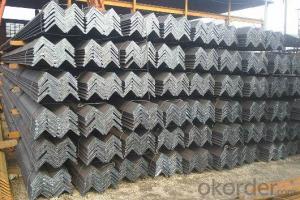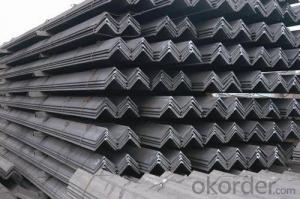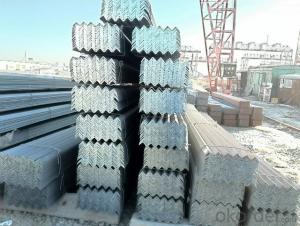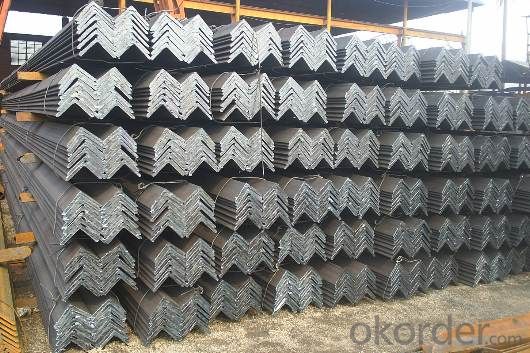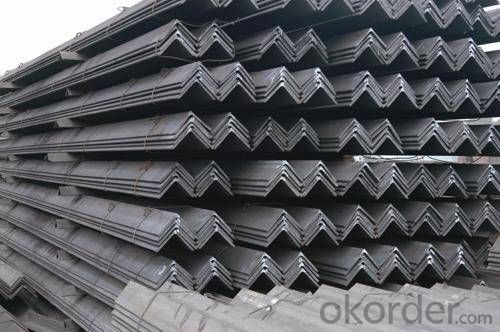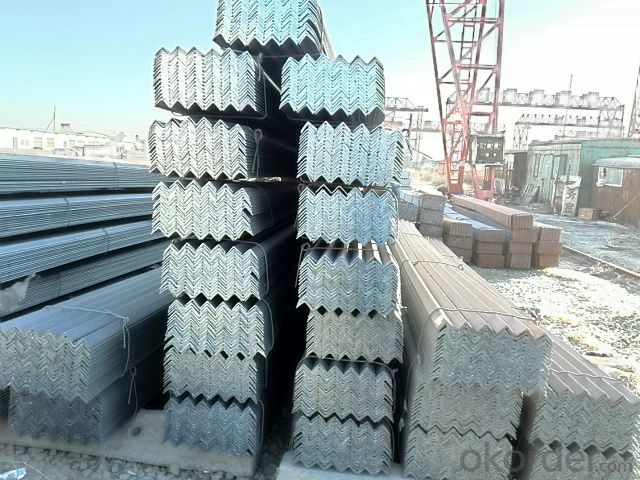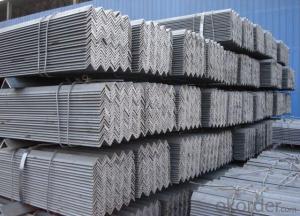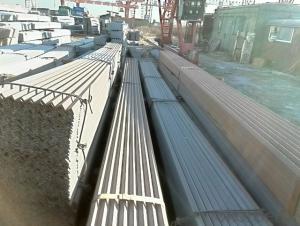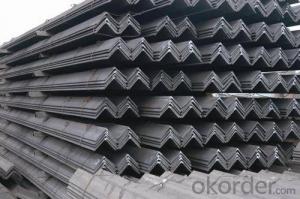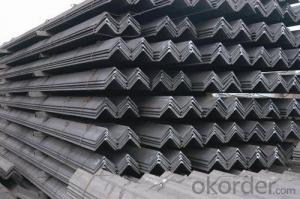Hot Rolled Angle Steel Bars with Highest Quality
- Loading Port:
- Tianjin
- Payment Terms:
- TT OR LC
- Min Order Qty:
- 25 m.t
- Supply Capability:
- 10000 m.t/month
OKorder Service Pledge
OKorder Financial Service
You Might Also Like
OKorder is offering Hot Rolled Equal Angles at great prices with worldwide shipping. Our supplier is a world-class manufacturer of steel, with our products utilized the world over. OKorder annually supplies products to European, North American and Asian markets. We provide quotations within 24 hours of receiving an inquiry and guarantee competitive prices.
Product Applications:
Hot Rolled Equal Angles are ideal for structural applications and are widely used in the construction of buildings and bridges, and the manufacturing, petrochemical, and transportation industries.
Product Advantages:
OKorder's Hot Rolled Equal Angles are durable, strong, and resist corrosion.
Main Product Features:
· Premium quality
· Prompt delivery & seaworthy packing (30 days after receiving deposit)
· Corrosion resistance
· Can be recycled and reused
· Mill test certification
· Professional Service
· Competitive pricing
Product Specifications:
Manufacture: Hot rolled
Grade: Q195 – 235
Certificates: ISO, SGS, BV, CIQ
Length: 6m – 12m, as per customer request
Packaging: Export packing, nude packing, bundled
Sizes: 25mm-250mm | ||
a*t | ||
25*2.5-4.0 | 70*6.0-9.0 | 130*9.0-15 |
30*2.5-6.6 | 75*6.0-9.0 | 140*10-14 |
36*3.0-5.0 | 80*5.0-10 | 150*10-20 |
38*2.3-6.0 | 90*7.0-10 | 160*10-16 |
40*3.0-5.0 | 100*6.0-12 | 175*12-15 |
45*4.0-6.0 | 110*8.0-10 | 180*12-18 |
50*4.0-6.0 | 120*6.0-15 | 200*14-25 |
60*4.0-8.0 | 125*8.0-14 | 250*25 |
FAQ:
Q1: Why buy Materials & Equipment from OKorder.com?
A1: All products offered byOKorder.com are carefully selected from China's most reliable manufacturing enterprises. Through its ISO certifications, OKorder.com adheres to the highest standards and a commitment to supply chain safety and customer satisfaction.
Q2: Can fit in the containers of 20fts the steel beams of 6M?
A2: No problem, we can put them into the containers in sideling form.
Q3: Can stainless steel rust?
A3: Stainless does not "rust" as you think of regular steel rusting with a red oxide on the surface that flakes off. If you see red rust it is probably due to some iron particles that have contaminated the surface of the stainless steel and it is these iron particles that are rusting. Look at the source of the rusting and see if you can remove it from the surface.
Images:
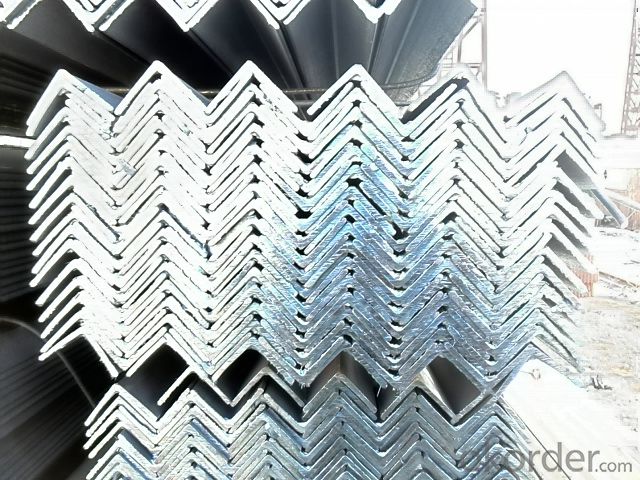
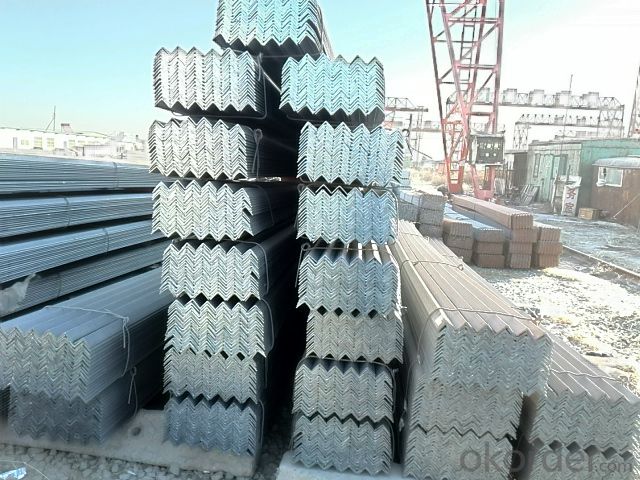
- Q: How do you design connections for steel angles?
- Designing connections for steel angles involves several key steps. Firstly, determine the loads that the connection will need to withstand, such as vertical and horizontal forces, moments, and shear forces. This will help determine the required strength and size of the connection. Next, select an appropriate connection type based on the specific application and load requirements. Common connection types for steel angles include bolted connections, welded connections, and a combination of both. In the case of bolted connections, design the connection by calculating the required number and size of bolts based on the applied loads. Consider factors such as bolt spacing and edge distances to ensure proper load transfer and prevent failure. For welded connections, ensure that the angles are properly prepared, aligned, and welded in accordance with the applicable codes and standards. Proper welding techniques and procedures should be followed to ensure the integrity and strength of the connection. During the design process, it is important to consider factors such as material properties, joint configurations, and the potential for corrosion or fatigue. Additionally, it is essential to consult relevant design codes and standards, such as the American Institute of Steel Construction (AISC) Manual, to ensure compliance and safety. Overall, designing connections for steel angles requires careful consideration of loads, connection types, and construction techniques to ensure a secure and reliable connection that meets the structural requirements.
- Q: Can steel angles be used for door frames?
- Yes, steel angles can be used for door frames. Steel angles provide strength and stability, making them a suitable choice for supporting and reinforcing door frames.
- Q: What are the common grades of steel used for angles?
- The specific application and requirements determine the various common grades of steel used for angles. Amongst these, A36, A572-50, and A588 are the most frequently utilized. A36, known for its strength and versatility, is a low carbon steel commonly employed in construction and structural applications. A572-50, on the other hand, is a high-strength, low-alloy steel widely used in structural applications due to its exceptional weldability and formability. In contrast, A588, a high-strength, low-alloy steel, finds its primary use in outdoor applications like bridges and buildings, owing to its excellent corrosion resistance. These grades of steel possess distinct characteristics and properties, enabling diverse applications and ensuring adherence to specific project requirements.
- Q: What is the typical yield stress of steel angles?
- The typical yield stress of steel angles can vary depending on the specific grade and type of steel being used. However, for commonly used carbon steels, the typical yield stress ranges from 36,000 to 50,000 pounds per square inch (psi). This means that the steel angles can withstand a certain amount of stress or pressure before they begin to deform or permanently change shape. It is important to note that different steel alloys and treatments can result in varying yield stresses, so it is necessary to consult the specific specifications or reference materials for the particular steel angle in question.
- Q: Can steel angles be used for fencing and gates?
- Yes, steel angles can be used for fencing and gates. Steel angles are a popular choice for fencing and gate installations due to their strength, durability, and versatility. They provide structural support and can be easily welded or bolted together to create sturdy and secure fencing or gate systems. Steel angles are also resistant to weathering and corrosion, which makes them suitable for outdoor applications. Additionally, they can be customized to various lengths, heights, and designs, allowing for flexibility in creating different styles of fences and gates. Overall, steel angles are a reliable and effective material for fencing and gate projects.
- Q: How do you prevent rust on steel angles?
- One way to prevent rust on steel angles is by applying a protective coating or paint that acts as a barrier against moisture and oxygen. Additionally, keeping the steel angles dry and storing them in a controlled environment with low humidity can help prevent rust formation. Regular inspections and maintenance, such as cleaning and removing any dirt or corrosion, can also help in preventing rust on steel angles.
- Q: What are the different test methods used to evaluate steel angles?
- There are several test methods used to evaluate steel angles in order to ensure their quality and suitability for various applications. These test methods include: 1. Tensile Test: This test measures the tensile strength, yield strength, and elongation properties of the steel angles. It involves applying a gradually increasing load to a specimen until it reaches its breaking point, allowing for assessment of the material's ability to resist forces without deforming or breaking. 2. Bend Test: The bend test evaluates the flexibility and ductility of steel angles. A specimen is bent to a specific angle and assessed for any signs of cracking, fracture, or deformation. This test is crucial in determining the angles' ability to withstand bending forces without compromising their structural integrity. 3. Charpy Impact Test: This test measures the impact resistance and toughness of steel angles by subjecting a notched specimen to a high-velocity impact. The amount of energy absorbed during the impact is measured, indicating the material's ability to resist sudden loads or shocks. 4. Hardness Test: The hardness test determines the steel angle's resistance to indentation or scratching. Different methods such as Rockwell, Brinell, or Vickers hardness tests may be employed to evaluate the material's hardness properties, which can help assess its durability and wear resistance. 5. Ultrasonic Testing: Ultrasonic testing uses high-frequency sound waves to detect flaws or defects within the steel angles. This non-destructive test method allows for the identification of internal cracks, voids, or inclusions that may affect the material's structural integrity. 6. Dimensional Inspection: This test method involves measuring the dimensions, tolerances, and geometric properties of the steel angles. It ensures that the angles meet the required specifications and can provide accurate information for engineering calculations and fabrication processes. By utilizing these various test methods, manufacturers, engineers, and quality control personnel can assess the mechanical properties, structural integrity, and overall quality of steel angles, ensuring their suitability for specific applications.
- Q: What are the disadvantages of using steel angles?
- There are several disadvantages of using steel angles in various applications. One of the main disadvantages is their susceptibility to corrosion. Steel angles are typically made from carbon steel, which is prone to rusting when exposed to moisture and harsh environmental conditions. This can lead to structural weakening and reduced durability over time. Another disadvantage is their weight and bulkiness. Steel angles are often heavy and bulky, making them difficult to handle and transport. This can increase the overall cost of the project, as special equipment or additional labor may be required for installation. Steel angles also have limited flexibility and versatility in terms of design. They are typically available in standard sizes and shapes, which can restrict their use in certain applications that require custom or intricate designs. This lack of flexibility may result in additional costs for fabrication or the need for alternative materials. Additionally, steel angles can be more expensive compared to other materials such as aluminum or wood. This can make them less cost-effective in certain projects, especially in situations where the structural requirements can be met with alternative materials that are more affordable. Lastly, steel angles can conduct heat and electricity, which may not be desirable in certain applications. This can pose safety risks in electrical or heat-sensitive environments, requiring additional insulation or protective measures. Overall, while steel angles offer several advantages such as high strength and durability, their disadvantages include susceptibility to corrosion, weight and bulkiness, limited flexibility in design, higher cost, and conductivity of heat and electricity. These factors should be carefully considered when deciding whether to use steel angles in a particular project.
- Q: Can steel angles be used for reinforcement bars?
- Steel angles cannot be used as reinforcement bars. Despite being made of steel, they possess different structural properties and serve different purposes. Reinforcement bars, or rebar, are specially designed to enhance the tensile strength and reinforcement of concrete structures. They have a ribbed or deformed surface that facilitates better bonding with the concrete. Conversely, steel angles are L-shaped structural components primarily employed for support and stability in construction endeavors. They are unsuitable for providing the necessary tensile strength and bonding required for concrete reinforcement. Hence, it is imperative to use the appropriate materials for their intended purposes to ensure the construction project's structural integrity and safety.
- Q: Are steel angles resistant to chemicals?
- Yes, steel angles are generally resistant to chemicals due to their high durability and corrosion resistance. However, their resistance may vary depending on the specific type of chemical and environment they are exposed to.
Send your message to us
Hot Rolled Angle Steel Bars with Highest Quality
- Loading Port:
- Tianjin
- Payment Terms:
- TT OR LC
- Min Order Qty:
- 25 m.t
- Supply Capability:
- 10000 m.t/month
OKorder Service Pledge
OKorder Financial Service
Similar products
Hot products
Hot Searches
Related keywords
